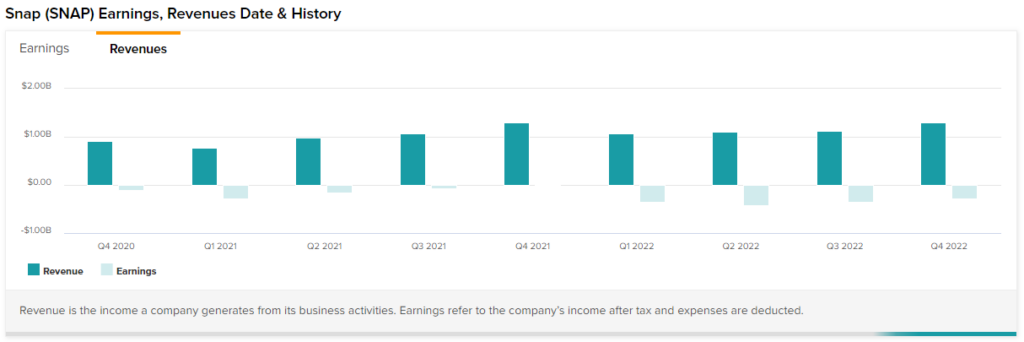Snap (NYSE:SNAP) is currently experiencing a cash crunch, compelling the company to engage in a race against time to achieve sustainable profitability. Unfortunately, despite Snapchat’s ascent into a well-established social media network, there has been a dearth of noteworthy developments recently. In the meantime, revenue growth has been sluggish, expenses are on the rise, and the balance sheet has been weakening. Given this set of facts, I am bearish on the stock.
Meet Your ETF AI Analyst
- Discover how TipRanks' ETF AI Analyst can help you make smarter investment decisions
- Explore ETFs TipRanks' users love and see what insights the ETF AI Analyst reveals about the ones you follow.
Sluggish Revenue Growth and Rising Costs: A Troubling Trend
Snap’s core problem can be distilled into a basic equation: decelerating revenue growth plus rising costs equals a challenging predicament. This equation has left Snap trapped in a difficult position where generating consistent profits seems unattainable.
To provide context, when Snap went public in 2017, it was viewed as a company with immense potential for hypergrowth. However, Snap’s momentum has been rapidly declining. In particular, revenue growth in 2016, 2017, and 2018 was 589.5%, 103.6%, and 43.1%, respectively. While growth somewhat rebounded in 2020 and 2021 due to improved platform activity during the pandemic, Snap has since lost this momentum.
In 2022, it reported its lowest revenue growth ever at 11.8%. This downward trend is further reinforced by the fact that in its most recent Q4 results, revenue growth was a meager 0.14%, representing the worst performance in Snap’s history.
However, Snap’s rising expenses do not align with this trend. The company’s approach to certain expenditures is especially perplexing. Take its research & development costs, for instance, which almost doubled over the past two years. Last year, in particular, they grew by 31.3% to $2.1 billion.
Why would management increase R&D spending by this much at a time when its revenues struggle to grow? To illustrate how insane their R&D spending is, the $2.1 billion represented about 45.7% of Snap’s total revenues for the year.
It’s particularly puzzling since Snap should be prioritizing reaching profitability at its current state. But instead, its lack of cost control has resulted in widening losses. The company posted a net loss of $1.43 billion in 2022, its biggest loss in five years and notably more than the still-significant $488 million lost in 2021.

It’s no wonder, then, that since Snap has never recorded a profitable year, the company always needs more cash. In fact, its cash position now stands at $3.94 billion, a notable decline from Q1 2022, when it was about $5.0 billion. Wall Street’s consensus estimates expect that the company will lose about another $1.08 billion this year, an improvement from last year’s $1.43 billion but still a massive loss.
Snap May Need to Raise More Cash; No Profitability Roadmap
With no apparent roadmap to reach profitability at this pace of losses, it won’t be more than a couple of years from when Snap will need to raise cash again. However, doing so in the current environment via either debt or equity would be nearly catastrophic.
While taking on more debt could provide temporary relief, it would ultimately result in long-term suffering. Snap’s total debt position already stands at a substantial $4.2 billion, representing nearly a 60% increase from the previous year, as the company had to once again tap the debt market to keep its cash position at adequate levels.
Undertaking more debt in a rising-rates environment may increase Snap’s current liquidity, but lofty interest expenses will cripple any chances the company might have in reporting positive net income in the coming years.
Alternatively, if Snap were to issue more shares, investors would likely lose confidence in the company’s ability to prioritize their interests, as heavy dilution has already occurred. Since 2017, Snap’s share count has surged by almost 37% due to excessive stock-based compensation. In fact, stock-based compensation increased by 27%, displaying a lack of awareness from management regarding the company’s declining performance and shareholder-friendly practices.
Overall, issuing more stock at Snap’s present price levels would lead to harmful dilution and place significant pressure on the stock price, especially given all the recent developments.
Is SNAP Stock a Buy, According to Analysts?
Turning to Wall Street, Snap has a Hold consensus rating based on four Buys, 17 Holds, and three Sells assigned in the past three months. At $10.63, the average Snap stock forecast suggests 2.3% downside potential over the next 12 months.

The Takeaway
Although Snap’s shares have already fallen by approximately 86% from their all-time high levels in 2021, it seems that the stock remains exposed to substantial downside risk. The company’s revenue growth has completely stalled, losses are expanding, and analysts anticipate another year of substantial losses in 2023.
This indicates that the company will require a cash injection sooner rather than later, and any measures taken to raise money will lead to further depletion of shareholders’ equity. In light of the absence of a clear strategy from management to reverse this trend, it’s difficult to envision how Snap’s stock could gain traction from its current position.
















